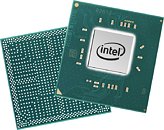- Joined
- Oct 9, 2007
- Messages
- 47,878 (7.38/day)
- Location
- Dublin, Ireland
| System Name | RBMK-1000 |
|---|---|
| Processor | AMD Ryzen 7 5700G |
| Motherboard | Gigabyte B550 AORUS Elite V2 |
| Cooling | DeepCool Gammax L240 V2 |
| Memory | 2x 16GB DDR4-3200 |
| Video Card(s) | Galax RTX 4070 Ti EX |
| Storage | Samsung 990 1TB |
| Display(s) | BenQ 1440p 60 Hz 27-inch |
| Case | Corsair Carbide 100R |
| Audio Device(s) | ASUS SupremeFX S1220A |
| Power Supply | Cooler Master MWE Gold 650W |
| Mouse | ASUS ROG Strix Impact |
| Keyboard | Gamdias Hermes E2 |
| Software | Windows 11 Pro |
The latest patches to Intel's open-source *nix drivers drop hints of a new low-power SoC in the works, codenamed "Elkhart Lake" featuring the company's most advanced integrated graphics solution. "Elkhart Lake" is a 10 nm SoC that combines a CPU complex based on the "Tremont" microarchitecture, with an iGPU based on the company's Gen11 architecture. Gen11 makes its debut with the company's 10 nm "Ice Lake" processors, promising big gains in graphics performance. Prototypes of a typical variant of Gen11 have been found to feature a compute throughput of 1 TFLOP/s, making them perform roughly on par with AMD's current "Raven Ridge" processors.

View at TechPowerUp Main Site

View at TechPowerUp Main Site







